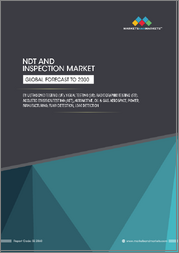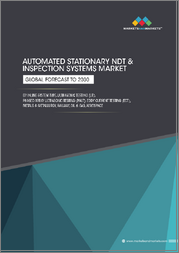
|
시장보고서
상품코드
1636001
자동차용 초음파 기술 시장 보고서 : 유형별, 차종별, 용도별, 지역별(2025-2033년)Automotive Ultrasonic Technologies Market Report by Type, Vehicle Type, Application, and Region 2025-2033 |
||||||
IMARC Group은 자동차용 초음파 기술 시장 세계 시장 규모가 2024년에 19억 달러에 달했으며, 2025년부터 2033년까지 6.8%의 연평균 성장률(CAGR)로 2033년에는 34억 달러에 달할 것으로 예측하고 있습니다. 자동차 안전 기능에 대한 수요 증가, 교통 안전의 중요성에 대한 소비자의 인식 증가, 가처분 소득 수준의 증가가 시장을 주도하는 주요 요인 중 일부입니다.
자동차용 초음파 기술은 초음파를 이용하여 차량 주변의 물체를 감지하거나 측정하는 기술이며, 보통 20kHz 이상의 주파수를 가지고 있습니다. 자동차용 초음파 센서는 음파를 이용하여 센서와 물체와의 거리를 측정하는 것으로, 주차나 조향을 보조하기 위해 앞범퍼나 뒷범퍼 등 차량의 다양한 부분에 장착할 수 있습니다. 차량용 초음파 기술은 물체의 접근을 감지하여 시각적 또는 청각적 지시를 제공하는 주차 보조 시스템, 충돌을 피하기 위해 속도를 조절하는 충돌 회피 시스템, 운전자의 사각지대에 있는 차량이나 물체를 감지하는 사각지대 감시 시스템 등에 일반적으로 사용되고 있습니다. 자동차용 초음파 기술은 카메라나 레이더와 같은 다른 센서에 비해 부드러운 물체나 불규칙한 형태의 물체를 감지할 수 있습니다. 또한 악천후에서도 정확하고 신뢰할 수 있는 측정이 가능한 등 몇 가지 장점이 있습니다. 또한, 상대적으로 저렴하고 유지보수가 최소화됩니다.
자동차용 초음파 기술 시장 동향:
세계 시장의 주요 원동력은 ADAS(첨단 운전자 보조 시스템) 등 자동차의 안전 기능에 대한 수요 증가입니다. 그 배경에는 특히 교통사고가 많은 신흥국에서 교통안전의 중요성에 대한 소비자의 인식이 높아진 것이 주요 요인으로 작용하고 있습니다. 이에 따라 고주파 초음파 센서의 도입, 인공지능(AI), 사물인터넷(IoT) 등 자동차용 초음파 기술의 수많은 기술 발전이 시장을 견인하고 있습니다. 또한, 자동차의 전기화라는 새로운 트렌드와 전 세계적으로 자동차 배기가스 감축에 대한 관심이 높아지면서 전기자동차(EV)의 인기가 높아짐에 따라 제품 보급이 증가하고 있습니다. 이와 더불어, 자동차에 정확한 거리 측정을 제공하기 위한 효율적인 주차 지원 시스템 및 장애물 감지 시스템에 대한 수요 증가는 시장에 유리한 성장 기회를 창출하고 있습니다. 그 외 시장 확대 요인으로는 가처분 소득 수준 증가, 고급 자율주행 자동차의 채택 증가, 자동차 안전 기능 탑재를 의무화하는 유리한 정부 규제, 광범위한 R&D 활동 등이 있습니다.
본 보고서에서 다루는 주요 질문
- 세계 자동차용 초음파 기술 시장은 지금까지 어떻게 성장해왔고, 앞으로 어떻게 변화할 것인가?
- 자동차용 초음파 기술 시장 세계 시장에서의 촉진요인, 억제요인 및 기회는 무엇인가?
- 주요 지역 시장이란?
- 가장 매력적인 자동차용 초음파 기술 시장은 어느 국가인가?
- 유형별 시장 분석은?
- 차종별 시장 현황은?
- 용도별 시장 내역은?
- 세계 자동차용 초음파 기술 시장의 경쟁 구조는?
- 자동차용 초음파 기술 시장 세계 시장에서 주요 플레이어/기업은?
목차
제1장 서문
제2장 조사 범위와 조사 방법
- 조사 목적
- 이해관계자
- 데이터 소스
- 1차 정보
- 2차 정보
- 시장 추정
- 상향식 접근
- 하향식 접근
- 조사 방법
제3장 주요 요약
제4장 소개
- 개요
- 주요 업계 동향
제5장 세계의 자동차용 초음파 기술 시장
- 시장 개요
- 시장 실적
- COVID-19의 영향
- 시장 예측
제6장 시장 내역 : 유형별
- 근접 검출
- 시장 동향
- 시장 예측
- 범위 측정
- 시장 동향
- 시장 예측
제7장 시장 내역 : 차종별
- 승용차
- 시장 동향
- 시장 예측
- 소형 상용차
- 시장 동향
- 시장 예측
- 대형 상용차
- 시장 동향
- 시장 예측
- 전기자동차
- 시장 동향
- 시장 예측
제8장 시장 내역 : 용도별
- 주차 어시스트
- 시장 동향
- 시장 예측
- 사각지대감지
- 시장 동향
- 시장 예측
- 기타
- 시장 동향
- 시장 예측
제9장 시장 내역 : 지역별
- 북미
- 미국
- 캐나다
- 아시아태평양
- 중국
- 일본
- 인도
- 한국
- 호주
- 인도네시아
- 기타
- 유럽
- 독일
- 프랑스
- 영국
- 이탈리아
- 스페인
- 러시아
- 기타
- 라틴아메리카
- 브라질
- 멕시코
- 기타
- 중동 및 아프리카
제10장 촉진요인, 억제요인, 기회
- 개요
- 성장 촉진요인
- 성장 억제요인
- 기회
제11장 밸류체인 분석
제12장 Porter's Five Forces 분석
- 개요
- 구매자의 교섭력
- 공급 기업의 교섭력
- 경쟁 정도
- 신규 참여업체의 위협
- 대체품의 위협
제13장 가격 분석
제14장 경쟁 구도
- 시장 구조
- 주요 기업
- 주요 기업 개요
- Aisin Corporation
- Continental AG
- Elmos Semiconductor SE
- Hella KGaA Hueck & Co.(Faurecia SE)
- Hyundai Motor Company
- Magna International Inc.
- Murata Manufacturing Co. Ltd.
- Panasonic Holdings Corporation
- Robert Bosch GmbH
- TDK Corporation
- Texas Instruments Inc.
- Valeo
The global automotive ultrasonic technologies market size reached USD 1.9 Billion in 2024. Looking forward, IMARC Group expects the market to reach USD 3.4 Billion by 2033, exhibiting a growth rate (CAGR) of 6.8% during 2025-2033. The augmenting demand for safety features in vehicles, increasing awareness among consumers about the importance of road safety, and inflating disposable income levels represent some of the key factors driving the market.
Automotive ultrasonic technologies are techniques that use ultrasonic waves to detect or measure objects in the vicinity of a vehicle, usually having a frequency above 20 kHz. Automotive ultrasonic sensors use sound waves to measure the distance between the sensor and the object, and can be mounted on various parts of a vehicle, such as the front or rear bumper, to aid in parking and maneuvering. Automotive ultrasonic technologies are commonly used in parking assist systems to detect the proximity of objects to provide visual or auditory directions, in collision avoidance systems to adjust the speed to avoid a collision, and in blind spot monitoring systems to detect vehicles or objects in the driver's blind spot. Automotive ultrasonic technologies are able to detect soft or irregularly shaped objects as compared to other sensors, such as cameras or radar. They provide several advantages such as accurate and reliable measurements even in adverse weather conditions. In addition to this, they are relatively inexpensive and require minimal maintenance.
Automotive Ultrasonic Technologies Market Trends:
The global market is primarily driven by the augmenting demand for safety features in vehicles, such as advanced driver assistance systems (ADAS). This can be attributed to the increasing awareness among consumers about the importance of road safety, especially in developing countries with a higher prevalence of road accidents. In line with this, numerous technological advancements in the automotive ultrasonic technology, including the introduction of high-frequency ultrasonic sensors, artificial intelligence (AI) and the internet of things (IoT), is propelling the market. Additionally, the emerging trend of vehicle electrification, along with the rising popularity of electric vehicles (EVs) due to an increasing focus on reducing vehicular emissions across the globe is resulting in a higher product uptake. Besides this, the escalating demand for efficient parking assistance and obstacle detection systems for providing accurate range measurement in automobiles is creating lucrative growth opportunities in the market. Some of the other factors contributing to the market include the inflating disposable income levels, rising adoption of luxury autonomous vehicles, favorable government regulations mandating the installation of safety features in vehicles, and extensive research and development (R&D) activities.
Key Market Segmentation:
Type Insights
Proximity Detection
Range Measurement
Vehicle Type Insights
Passenger Cars
Light Commercial Vehicles
Heavy Commercial Vehicles
Electric Vehicles
Application Insights
Park Assist
Blind Spot Detection
Others
Regional Insights
North America
United States
Canada
Asia Pacific
China
Japan
India
South Korea
Australia
Indonesia
Others
Europe
Germany
France
United Kingdom
Italy
Spain
Russia
Others
Latin America
Brazil
Mexico
Others
Middle East and Africa
The report has also provided a comprehensive analysis of all the major regional markets, which include North America (the United States and Canada); Europe (Germany, France, the United Kingdom, Italy, Spain, and others); Asia Pacific (China, Japan, India, South Korea, Australia, Indonesia, and others); Latin America (Brazil, Mexico, and others); and the Middle East and Africa. According to the report, Asia Pacific was the largest market for automotive ultrasonic technologies. Some of the factors driving the Asia Pacific automotive ultrasonic technologies market included the escalating demand for efficient parking assistance, the augmenting demand for safety features in vehicles, extensive research and development activities, etc.
Competitive Landscape:
The report has also provided a comprehensive analysis of the competitive landscape in the global automotive ultrasonic technologies market. Competitive analysis such as market structure, market share by key players, player positioning, top winning strategies, competitive dashboard, and company evaluation quadrant has been covered in the report. Also, detailed profiles of all major companies have been provided. Some of the companies covered include Aisin Corporation, Continental AG, Elmos Semiconductor SE, Hella KGaA Hueck & Co. (Faurecia SE), Hyundai Motor Company, Magna International Inc., Murata Manufacturing Co. Ltd., Panasonic Holdings Corporation, Robert Bosch GmbH, TDK Corporation, Texas Instruments Inc., Valeo., etc.
Key Questions Answered in This Report:
- How has the global automotive ultrasonic technologies market performed so far and how will it perform in the coming years?
- What are the drivers, restraints, and opportunities in the global automotive ultrasonic technologies market?
- What are the key regional markets?
- Which countries represent the most attractive automotive ultrasonic technologies markets?
- What is the breakup of the market based on the type?
- What is the breakup of the market based on the vehicle type?
- What is the breakup of the market based on the application?
- What is the competitive structure of the global automotive ultrasonic technologies market?
- Who are the key players/companies in the global automotive ultrasonic technologies market?
Table of Contents
1 Preface
2 Scope and Methodology
- 2.1 Objectives of the Study
- 2.2 Stakeholders
- 2.3 Data Sources
- 2.3.1 Primary Sources
- 2.3.2 Secondary Sources
- 2.4 Market Estimation
- 2.4.1 Bottom-Up Approach
- 2.4.2 Top-Down Approach
- 2.5 Forecasting Methodology
3 Executive Summary
4 Introduction
- 4.1 Overview
- 4.2 Key Industry Trends
5 Global Automotive Ultrasonic Technologies Market
- 5.1 Market Overview
- 5.2 Market Performance
- 5.3 Impact of COVID-19
- 5.4 Market Forecast
6 Market Breakup by Type
- 6.1 Proximity Detection
- 6.1.1 Market Trends
- 6.1.2 Market Forecast
- 6.2 Range Measurement
- 6.2.1 Market Trends
- 6.2.2 Market Forecast
7 Market Breakup by Vehicle Type
- 7.1 Passenger Cars
- 7.1.1 Market Trends
- 7.1.2 Market Forecast
- 7.2 Light Commercial Vehicles
- 7.2.1 Market Trends
- 7.2.2 Market Forecast
- 7.3 Heavy Commercial Vehicles
- 7.3.1 Market Trends
- 7.3.2 Market Forecast
- 7.4 Electric Vehicles
- 7.4.1 Market Trends
- 7.4.2 Market Forecast
8 Market Breakup by Application
- 8.1 Park Assist
- 8.1.1 Market Trends
- 8.1.2 Market Forecast
- 8.2 Blind Spot Detection
- 8.2.1 Market Trends
- 8.2.2 Market Forecast
- 8.3 Others
- 8.3.1 Market Trends
- 8.3.2 Market Forecast
9 Market Breakup by Region
- 9.1 North America
- 9.1.1 United States
- 9.1.1.1 Market Trends
- 9.1.1.2 Market Forecast
- 9.1.2 Canada
- 9.1.2.1 Market Trends
- 9.1.2.2 Market Forecast
- 9.1.1 United States
- 9.2 Asia-Pacific
- 9.2.1 China
- 9.2.1.1 Market Trends
- 9.2.1.2 Market Forecast
- 9.2.2 Japan
- 9.2.2.1 Market Trends
- 9.2.2.2 Market Forecast
- 9.2.3 India
- 9.2.3.1 Market Trends
- 9.2.3.2 Market Forecast
- 9.2.4 South Korea
- 9.2.4.1 Market Trends
- 9.2.4.2 Market Forecast
- 9.2.5 Australia
- 9.2.5.1 Market Trends
- 9.2.5.2 Market Forecast
- 9.2.6 Indonesia
- 9.2.6.1 Market Trends
- 9.2.6.2 Market Forecast
- 9.2.7 Others
- 9.2.7.1 Market Trends
- 9.2.7.2 Market Forecast
- 9.2.1 China
- 9.3 Europe
- 9.3.1 Germany
- 9.3.1.1 Market Trends
- 9.3.1.2 Market Forecast
- 9.3.2 France
- 9.3.2.1 Market Trends
- 9.3.2.2 Market Forecast
- 9.3.3 United Kingdom
- 9.3.3.1 Market Trends
- 9.3.3.2 Market Forecast
- 9.3.4 Italy
- 9.3.4.1 Market Trends
- 9.3.4.2 Market Forecast
- 9.3.5 Spain
- 9.3.5.1 Market Trends
- 9.3.5.2 Market Forecast
- 9.3.6 Russia
- 9.3.6.1 Market Trends
- 9.3.6.2 Market Forecast
- 9.3.7 Others
- 9.3.7.1 Market Trends
- 9.3.7.2 Market Forecast
- 9.3.1 Germany
- 9.4 Latin America
- 9.4.1 Brazil
- 9.4.1.1 Market Trends
- 9.4.1.2 Market Forecast
- 9.4.2 Mexico
- 9.4.2.1 Market Trends
- 9.4.2.2 Market Forecast
- 9.4.3 Others
- 9.4.3.1 Market Trends
- 9.4.3.2 Market Forecast
- 9.4.1 Brazil
- 9.5 Middle East and Africa
- 9.5.1 Market Trends
- 9.5.2 Market Breakup by Country
- 9.5.3 Market Forecast
10 Drivers, Restraints, and Opportunities
- 10.1 Overview
- 10.2 Drivers
- 10.3 Restraints
- 10.4 Opportunities
11 Value Chain Analysis
12 Porters Five Forces Analysis
- 12.1 Overview
- 12.2 Bargaining Power of Buyers
- 12.3 Bargaining Power of Suppliers
- 12.4 Degree of Competition
- 12.5 Threat of New Entrants
- 12.6 Threat of Substitutes
13 Price Analysis
14 Competitive Landscape
- 14.1 Market Structure
- 14.2 Key Players
- 14.3 Profiles of Key Players
- 14.3.1 Aisin Corporation
- 14.3.1.1 Company Overview
- 14.3.1.2 Product Portfolio
- 14.3.1.3 Financials
- 14.3.1.4 SWOT Analysis
- 14.3.2 Continental AG
- 14.3.2.1 Company Overview
- 14.3.2.2 Product Portfolio
- 14.3.2.3 Financials
- 14.3.2.4 SWOT Analysis
- 14.3.3 Elmos Semiconductor SE
- 14.3.3.1 Company Overview
- 14.3.3.2 Product Portfolio
- 14.3.3.3 Financials
- 14.3.3.4 SWOT Analysis
- 14.3.4 Hella KGaA Hueck & Co. (Faurecia SE)
- 14.3.4.1 Company Overview
- 14.3.4.2 Product Portfolio
- 14.3.4.3 Financials
- 14.3.5 Hyundai Motor Company
- 14.3.5.1 Company Overview
- 14.3.5.2 Product Portfolio
- 14.3.5.3 Financials
- 14.3.5.4 SWOT Analysis
- 14.3.6 Magna International Inc.
- 14.3.6.1 Company Overview
- 14.3.6.2 Product Portfolio
- 14.3.6.3 Financials
- 14.3.6.4 SWOT Analysis
- 14.3.7 Murata Manufacturing Co. Ltd.
- 14.3.7.1 Company Overview
- 14.3.7.2 Product Portfolio
- 14.3.7.3 Financials
- 14.3.7.4 SWOT Analysis
- 14.3.8 Panasonic Holdings Corporation
- 14.3.8.1 Company Overview
- 14.3.8.2 Product Portfolio
- 14.3.8.3 Financials
- 14.3.8.4 SWOT Analysis
- 14.3.9 Robert Bosch GmbH
- 14.3.9.1 Company Overview
- 14.3.9.2 Product Portfolio
- 14.3.9.3 SWOT Analysis
- 14.3.10 TDK Corporation
- 14.3.10.1 Company Overview
- 14.3.10.2 Product Portfolio
- 14.3.10.3 Financials
- 14.3.10.4 SWOT Analysis
- 14.3.11 Texas Instruments Inc.
- 14.3.11.1 Company Overview
- 14.3.11.2 Product Portfolio
- 14.3.11.3 Financials
- 14.3.11.4 SWOT Analysis
- 14.3.12 Valeo
- 14.3.12.1 Company Overview
- 14.3.12.2 Product Portfolio
- 14.3.12.3 Financials
- 14.3.12.4 SWOT Analysis
- 14.3.1 Aisin Corporation
Kindly, note that this only represents a partial list of companies, and the complete list has been provided in the report.



















